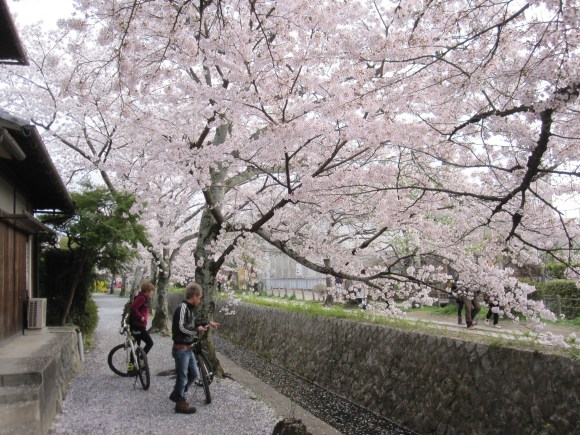
I used to work nights and weekends at my old job, and one particularly unlucky year I was missing all the cherry blossom parties friends were having while I was stuck in the office. I managed to catch a break, though, because right at the tail end of sakura season a girl I knew had a day off that matched up with one of mine, so we decided to go check out the flowers together.
We met at the station, walked down to the river, and the scenery was drop-dead gorgeous, like something out of a travel guide or some trendy Japanese TV drama or anime. After walking down a lantern-lit path lined with cherry trees in full bloom, we bought some snacks from a food stall in a park, sat down, and spent an hour or so soaking up the atmosphere.
It’s weird to think that in just a few days, all those achingly captivating pink petals would fall from their branches and be blown away by the wind. But hey, that’s what makes the sakura so special, right? Their beauty is that much greater because it’s so fleeting, right?
Yeah…I’m not sure I buy that.
Just about any Japanese cultural guidebook will tell you that the country’s residents love cherry blossom because the short-lived flowers are a perfect metaphor for the bittersweet moments of transient happiness in life and human relationships. To be fair, there’s some truth to that. No doubt influential is that the Japanese school year both ends and begins in spring, so the sakura tend to appear somewhere around the time people are saying good-bye to their classmates at graduation.
It’s also true that the temperamental blossoms only stick around for about two weeks, and the exact timing of when the flowers will begin to open is notoriously hard to predict. So yes, there’s definitely a certain “enjoy this while you can” mentality, but to say that it’s the only, or consistently main, thing that sets the tone for Japan’s appreciation of the cherry blossoms might be a bit of an exaggeration.
For starters, maybe most of the beauty of the cherry blossoms doesn’t come from their limited lifespan, but from the fact that they just look incredible.
▼ Would people seriously say “Eh, that’s not so pretty anymore” after more than 14 days of this?
The typical Japanese cherry blossom viewing party, or hanami as they’re known in their native Japanese, isn’t anywhere near as wistfully pensive as the somber image poems and love songs are so fond of ascribing to sakura. Most of them are more like slightly rowdy picnics, with plenty of munchies and enough alcohol to run a small bar. At the sakura gatherings I’ve been to, I don’t recall anyone sighing and waxing nostalgic about days gone by, regardless of the age of the participants, but I do recall a lot of laughter, plus one of my fellow revelers once good-naturedly tossing me into a cherry tree.
▼ Like I said, “enough alcohol to run a small bar.”
There’s even a subtle upside to the limited time in which the cherry blossoms bloom. In Japan, work and school generally come before everything else, and tending to those responsibilities means delaying more pleasurable things. But with such a short window of sakura opportunity, there’s a significant, implicit understanding that if people don’t clock out or take a break from studying now, they’re going to miss their chance to enjoy the flowers, so society cuts workers and students a bit of slack during those two special weeks in spring.
None of this is to say the claim that Japanese people like cherry blossoms because of their ephemeral, somewhat tragic nature is out-and-out wrong. At the same time, it’s not the only way people in Japan enjoy them. When you stop and think about it, that makes a lot of sense, because obsessing over the fact that the sakura you’re looking at right now are going to soon be gone ignores the equally certain truth that they’ll blossom again in 12 months’ time.
▼ “Be right back!”
Case in point: Weather-wise, this year has been one of the lousiest sakura seasons in the decade-plus I’ve lived in Japan, with rain and cold temperatures for almost the entire past week. But you know what? On the last night before the first rain clouds showed up for their extended stay, I managed to wrap up work at a reasonable hour.
Just down the street from my apartment, there’s a tiny little neighborhood park with about a half-dozen cherry trees. By happy coincidence, that same girl who I shared the quintessential sakura moment I talked about at the start of this article with was also free that night. I decided to ask her out again, and I had a pretty good hunch she’d say yes this time too, seeing as how we’re married now and all.
So we took a stroll down to the end of the block. We stopped at the 7-Eleven on the way to pick up some drinks, then sat on the bench in the park and looked up at the sakura, which weren’t really in full bloom yet, outlined against the night sky.
Was it as dramatic a setting as the riverside walkway lined with lanterns and cherry trees? Not really, but that didn’t mean the more humble surroundings weren’t beautiful in their own way. It didn’t put a damper on the night, or cast us into a solemnly reflective mood.
Even under less than optimum conditions, cherry blossoms are still a sight to see. Sure, you could focus on how the flowers are only temporary, but the trees themselves can live for centuries, producing a new batch of blossoms for each of those hundreds of springs. So if the stereotypical image of cherry blossoms is just too gloomy for you, here’s an alternative way to look at the situation.
A happy moment is a happy moment, regardless of how long it lasts. Put enough of those together, and you’ve got a happy life, with a chance to add another sakura-filled memory every 12 months.
Photos © RocketNews24

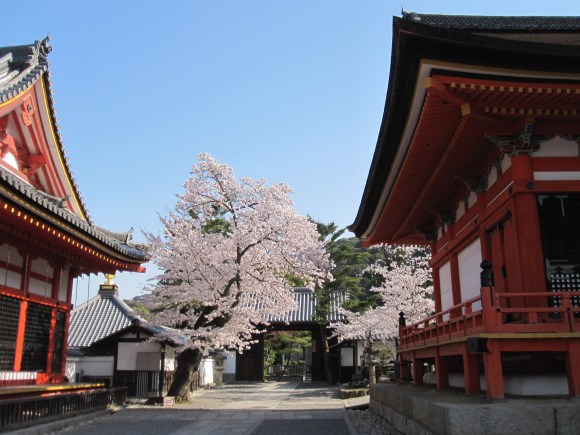
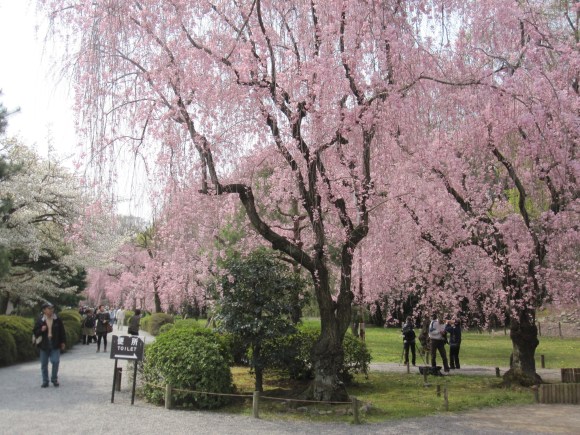
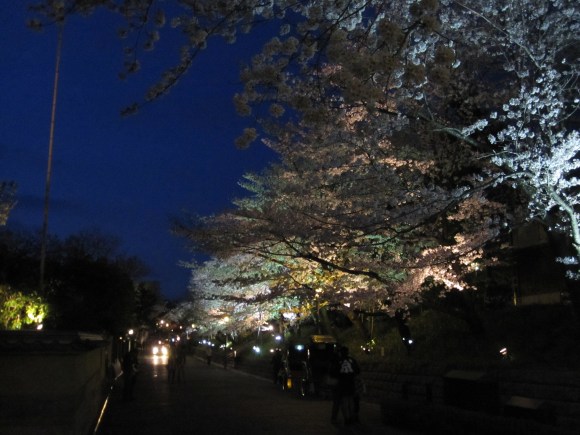

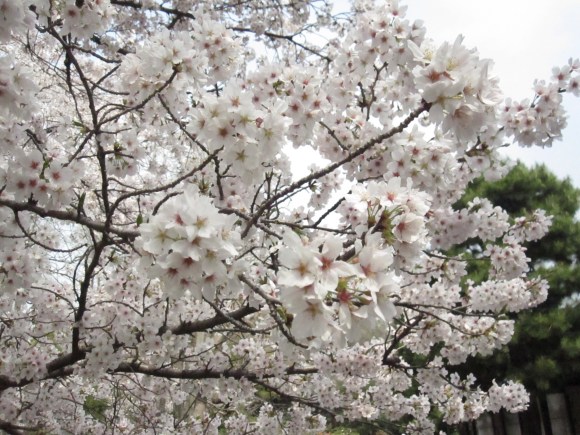
 Beyond sakura: How to tell a cherry blossom from a plum or peach flower
Beyond sakura: How to tell a cherry blossom from a plum or peach flower Snow sakura! Spring and winter collide as frost and cherry blossoms mingle in Japan 【Photos】
Snow sakura! Spring and winter collide as frost and cherry blossoms mingle in Japan 【Photos】 Sakura season officially begins in Tokyo as cherry blossoms bloom at Yasukuni Shrine
Sakura season officially begins in Tokyo as cherry blossoms bloom at Yasukuni Shrine Sakura jelly desserts are beautiful and back on sale so your “cherry blossoms will bloom”
Sakura jelly desserts are beautiful and back on sale so your “cherry blossoms will bloom” Revised full-bloom cherry blossom forecasts released for every prefecture in Japan
Revised full-bloom cherry blossom forecasts released for every prefecture in Japan We revisited Sweets Paradise after a decade to see if Japan’s dessert buffet still delivers
We revisited Sweets Paradise after a decade to see if Japan’s dessert buffet still delivers Hayao Miyazaki says Happy New Year to Studio Ghibli fans with new art for Year of the Horse
Hayao Miyazaki says Happy New Year to Studio Ghibli fans with new art for Year of the Horse 7 great places to see Mt. Fuji from without having to climb it
7 great places to see Mt. Fuji from without having to climb it Nearly half of Japanese women in survey have an idol singer or anime crush
Nearly half of Japanese women in survey have an idol singer or anime crush Uniqlo Ukiyo-e Blue T-shirts: A cool-hued reinterpretation of some of Japan’s greatest paintings
Uniqlo Ukiyo-e Blue T-shirts: A cool-hued reinterpretation of some of Japan’s greatest paintings Dom Dom Burger releasing Power-Ranger-themed Super Sentai Burger
Dom Dom Burger releasing Power-Ranger-themed Super Sentai Burger Cup Noodle releases new Tomica “car” collection
Cup Noodle releases new Tomica “car” collection Uniqlo opens its first-ever cafe at newly revamped Ginza store
Uniqlo opens its first-ever cafe at newly revamped Ginza store Is the all-you-can-eat KFC buffet in Tokyo really as good as they say it is?
Is the all-you-can-eat KFC buffet in Tokyo really as good as they say it is? “Denki Anma”: The Japanese traditional torment that you’ll be glad stays in Japan
“Denki Anma”: The Japanese traditional torment that you’ll be glad stays in Japan Starbucks Japan ready to get Year of the Horse started with adorable drinkware and plushies【Pics】
Starbucks Japan ready to get Year of the Horse started with adorable drinkware and plushies【Pics】 7-Eleven Japan’s ramen-cooking robot whipped us up a bowl of noodles【Taste test】
7-Eleven Japan’s ramen-cooking robot whipped us up a bowl of noodles【Taste test】 Cyberpunk anime meets traditional culture in Ghost in the Shell gold leaf Japanese changing screens
Cyberpunk anime meets traditional culture in Ghost in the Shell gold leaf Japanese changing screens Hello Kitty Choco Egg figures are an adorable trip through three periods of Japanese pop culture【Pics】
Hello Kitty Choco Egg figures are an adorable trip through three periods of Japanese pop culture【Pics】 Japan’s otoshidama tradition of giving kids money at New Year’s gets a social welfare upgrade
Japan’s otoshidama tradition of giving kids money at New Year’s gets a social welfare upgrade We found possibly the quietest Japanese-style hotel in Tokyo’s bustling Shinjuku district
We found possibly the quietest Japanese-style hotel in Tokyo’s bustling Shinjuku district Lacquerware supplier to emperor of Japan and Pokémon team up for new tableware
Lacquerware supplier to emperor of Japan and Pokémon team up for new tableware Sumo Sanrio! Hello Kitty and pals team up with Japan Sumo Association for new merch【Pics】
Sumo Sanrio! Hello Kitty and pals team up with Japan Sumo Association for new merch【Pics】 Can a dirty butthole make you filthy rich in Japan? We’re starting a New Year’s lottery experiment
Can a dirty butthole make you filthy rich in Japan? We’re starting a New Year’s lottery experiment 7-Eleven Japan starts new temporary luggage storage service in over 300 branches
7-Eleven Japan starts new temporary luggage storage service in over 300 branches Disillusionment at Tsukiji’s tourist-target prices led us to a great ramen restaurant in Tokyo
Disillusionment at Tsukiji’s tourist-target prices led us to a great ramen restaurant in Tokyo Starbucks teams up with 166-year-old Kyoto doll maker for Year of the Horse decorations【Photos】
Starbucks teams up with 166-year-old Kyoto doll maker for Year of the Horse decorations【Photos】 Tokyo considering law requiring more trash cans following litter increase in heavily touristed area
Tokyo considering law requiring more trash cans following litter increase in heavily touristed area Tokyo’s Tsukiji sushi neighborhood asks tour groups to stay away for the rest of the month
Tokyo’s Tsukiji sushi neighborhood asks tour groups to stay away for the rest of the month Nintendo’s Kirby now delivering orders at Kura Sushi restaurants, but not in Japan
Nintendo’s Kirby now delivering orders at Kura Sushi restaurants, but not in Japan Tokyo event lets you travel back in time, for free, to celebrate 100 years since Showa era start
Tokyo event lets you travel back in time, for free, to celebrate 100 years since Showa era start Sanrio theme park in Japan announces plans to expand into a Sanrio resort
Sanrio theme park in Japan announces plans to expand into a Sanrio resort Japan may add Japanese language proficiency, lifestyle classes to permanent foreign resident requirements
Japan may add Japanese language proficiency, lifestyle classes to permanent foreign resident requirements Survey asks foreign tourists what bothered them in Japan, more than half gave same answer
Survey asks foreign tourists what bothered them in Japan, more than half gave same answer Japan’s human washing machines will go on sale to general public, demos to be held in Tokyo
Japan’s human washing machines will go on sale to general public, demos to be held in Tokyo Japan’s deadliest food claims more victims, but why do people keep eating it for New Year’s?
Japan’s deadliest food claims more victims, but why do people keep eating it for New Year’s? We deeply regret going into this tunnel on our walk in the mountains of Japan
We deeply regret going into this tunnel on our walk in the mountains of Japan Studio Ghibli releases Kodama forest spirits from Princess Mononoke to light up your home
Studio Ghibli releases Kodama forest spirits from Princess Mononoke to light up your home Major Japanese hotel chain says reservations via overseas booking sites may not be valid
Major Japanese hotel chain says reservations via overseas booking sites may not be valid Put sesame oil in your coffee? Japanese maker says it’s the best way to start your day【Taste test】
Put sesame oil in your coffee? Japanese maker says it’s the best way to start your day【Taste test】 No more using real katana for tourism activities, Japan’s National Police Agency says
No more using real katana for tourism activities, Japan’s National Police Agency says Starbucks Japan reveals new sakura drinkware collection, inspired by evening cherry blossoms
Starbucks Japan reveals new sakura drinkware collection, inspired by evening cherry blossoms Updated cherry blossom forecast shows extra-long sakura season for Japan this year
Updated cherry blossom forecast shows extra-long sakura season for Japan this year Updated cherry blossom forecast has sakura reaching full bloom earlier than usual
Updated cherry blossom forecast has sakura reaching full bloom earlier than usual Sakura season officially starts in Tokyo as cherry blossoms begin blooming in the capital
Sakura season officially starts in Tokyo as cherry blossoms begin blooming in the capital Green cherry blossoms blooming now across Japan
Green cherry blossoms blooming now across Japan Japanese weather site reveals the secret to knowing when a sakura cherry blossom will fall
Japanese weather site reveals the secret to knowing when a sakura cherry blossom will fall Snow Sakura in Japan: A magical hanami cherry blossom viewing experience【Pics & Video】
Snow Sakura in Japan: A magical hanami cherry blossom viewing experience【Pics & Video】 Cherry blossoms are blooming in Japan in October, but why?
Cherry blossoms are blooming in Japan in October, but why? Updated sakura forecast: Cherry blossoms coming to Tokyo first, but later than first expected
Updated sakura forecast: Cherry blossoms coming to Tokyo first, but later than first expected Sakura Skytree photos take Tokyo’s breath away, give kick-start to cherry blossom season【Photos】
Sakura Skytree photos take Tokyo’s breath away, give kick-start to cherry blossom season【Photos】 Cherry blossom forecast updated with later start date, full-bloom predictions added
Cherry blossom forecast updated with later start date, full-bloom predictions added Sakura 2017: The best places to see cherry blossoms in Japan
Sakura 2017: The best places to see cherry blossoms in Japan Japan cherry blossom forecast 2019! Sakura coming earlier than usual to Tokyo
Japan cherry blossom forecast 2019! Sakura coming earlier than usual to Tokyo “People who break sakura branches are idiots” – Twitter outcry over cherry blossom accessories
“People who break sakura branches are idiots” – Twitter outcry over cherry blossom accessories Super-detailed cherry blossom forecast maps for 2025 show warm winter doesn’t mean early sakura
Super-detailed cherry blossom forecast maps for 2025 show warm winter doesn’t mean early sakura These stunningly beautiful seasonal pink flowers from Japan are NOT cherry blossoms【Photos】
These stunningly beautiful seasonal pink flowers from Japan are NOT cherry blossoms【Photos】
Leave a Reply